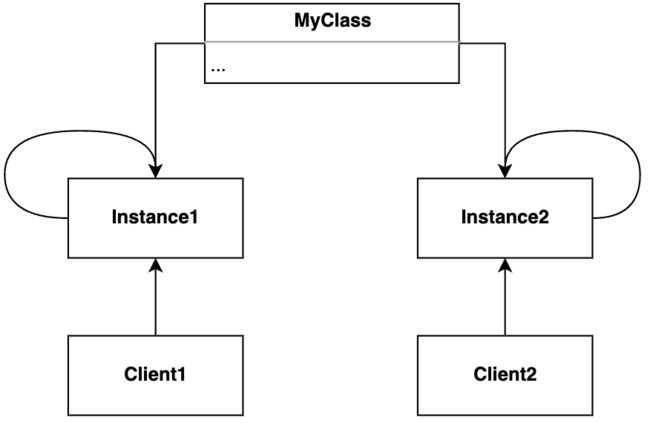【设计模式】第4节:创建型模式之“单例模式”
一、介绍
采取一定的方法保证在整个的软件系统中,对某个类只能存在一个对象实例,并且该类只提供一个取得其对象实例的方法。
不使用单例模式的UML类图:
使用单例模式的UML类图:
使用场景:
- 需要频繁创建或销毁的对象
- 创建对象耗时过多或耗费资源过多,但又经常用到
- 工具类对象
- 频繁访问数据库或文件的对象
二、Java版实现
1. 饿汉式(静态常量)
//饿汉式(静态变量)
class Singleton {
//1. 构造器私有化, 外部能new
private Singleton() {
}
//2.本类内部创建对象实例
private final static Singleton instance = new Singleton();
//3. 提供一个公有的静态方法,返回实例对象
public static Singleton getInstance() {
return instance;
}
}
优点:写法简单,在类装载的时候就完成了实例化,避免了线程同步问题。
缺点:在类加载的时候完成实例化,没有达到懒加载的效果,可能造成内存浪费。
2. 饿汉式(静态代码块)
//饿汉式(静态变量)
class Singleton {
//1. 构造器私有化, 外部能new
private Singleton() {
}
//2.本类内部创建对象实例
private static Singleton instance;
static { // 在静态代码块中,创建单例对象
instance = new Singleton();
}
//3. 提供一个公有的静态方法,返回实例对象
public static Singleton getInstance() {
return instance;
}
}
优缺点同上。
3. 懒汉式(线程不安全)
class Singleton {
private static Singleton instance;
private Singleton() {}
//提供一个静态的公有方法,当使用到该方法时,才去创建 instance
//即懒汉式
public static Singleton getInstance() {
if(instance == null) {
instance = new Singleton();
}
return instance;
}
}
优缺点:起到了懒加载的效果,但只能在单线程下使用,多线程可能创建多个实例。
3. 懒汉式(线程安全,同步方法)
// 懒汉式(线程安全,同步方法)
class Singleton {
private static Singleton instance;
private Singleton() {}
//提供一个静态的公有方法,加入同步处理的代码,解决线程安全问题
//即懒汉式
public static synchronized Singleton getInstance() {
if(instance == null) {
instance = new Singleton();
}
return instance;
}
}
优缺点:解决了线程安全问题,但效率太低,每个线程在想获得类的实例时候,都需要进行同步。
5. 双重检查
class Singleton {
private static volatile Singleton instance;
private Singleton() {}
//提供一个静态的公有方法,加入双重检查代码,解决线程安全问题, 同时解决懒加载问题
//同时保证了效率, 推荐使用
public static synchronized Singleton getInstance() {
if(instance == null) {
synchronized (Singleton.class) {
if(instance == null) {
instance = new Singleton();
}
}
}
return instance;
}
}
优缺点:实例代码只需要执行一次,后面再访问时,会被外层判空语句拦截,避免反复进行方法同步。延迟加载,效率较高。
6. 静态内部类
// 静态内部类完成, 推荐使用
class Singleton {
private static volatile Singleton instance;
//构造器私有化
private Singleton() {}
//写一个静态内部类,该类中有一个静态属性 Singleton
private static class SingletonInstance {
private static final Singleton INSTANCE = new Singleton();
}
//提供一个静态的公有方法,直接返回SingletonInstance.INSTANCE
public static synchronized Singleton getInstance() {
return SingletonInstance.INSTANCE;
}
}
静态内部类的特点:当外部类装载时,静态内部类不会立即实例化,而是在真正用到时才会实例化。并且静态内部类保证了线程的安全性。
7. 枚举
package com.atguigu.singleton.type8;
public class SingletonTest08 {
public static void main(String[] args) {
Singleton instance = Singleton.INSTANCE;
Singleton instance2 = Singleton.INSTANCE;
System.out.println(instance == instance2);
System.out.println(instance.hashCode());
System.out.println(instance2.hashCode());
instance.sayOK();
}
}
//使用枚举,可以实现单例, 推荐
enum Singleton {
INSTANCE; //属性
public void sayOK() {
System.out.println("ok~");
}
}
优缺点:不仅可以避免多线程同步问题,而且还能防止反序列化重新创建新的对象。
三、Golang版实现
1. 饿汉式
package main
import "fmt"
type Singleton struct {
Name string
}
var SingletonInstance Singleton
func init() {
SingletonInstance = Singleton{"singleTonName"};
}
func main() {
fmt.Printf("SingletonInstance: %v", SingletonInstance)
}
通过init函数在初始化的时候加载单例类的实例。
2. 懒汉式
package main
import (
"fmt"
"sync"
)
type Singleton struct {
Name string
}
var (
SingletonInstance Singleton
SingletonOnce sync.Once
)
func GetInstance() Singleton {
SingletonOnce.Do(func() {
SingletonInstance = Singleton{"SingletonName"}
})
return SingletonInstance
}
func main() {
GetInstance()
fmt.Printf("SingletonInstance: %v", SingletonInstance)
}
通过sync.Once实现在初次使用这个实例时才加载的效果。

